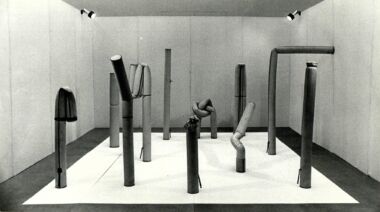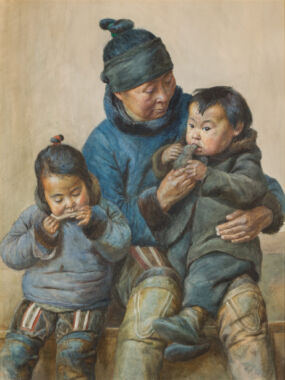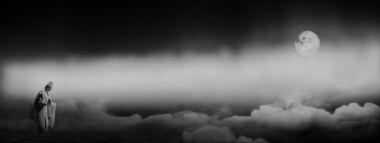Summary
P.S. Krøyer’s late and most popular paintings have proven very difficult to preserve, and as zinc white has been known to cause structural problems in paintings, the authors investigate if the damage seen in the late paintings can be related to the use of this relatively new pigment. Eight paintings were examined and the results suggest that the shift from using one white pigment to another took place between 1884 and 1889. After 1889, only zinc white was found in the analyzed paint layers. However, the results indicate that the recurring damage in Krøyer’s later paintings cannot be explained by the presence of zinc white alone.
Articles
Introduction
Peder Severin Krøyer (1851-1909) was a leading naturalistic painter in Denmark in the late 1800s. Conservators have reported extensive problems with his paintings in conservation reports and condition surveys, which suggests a connection between his painting technique and the reported mechanical damage. Despite this, very little research has been done into the media and painting techniques of Krøyer, nor is a thorough investigation of the preservation of his paintings available.
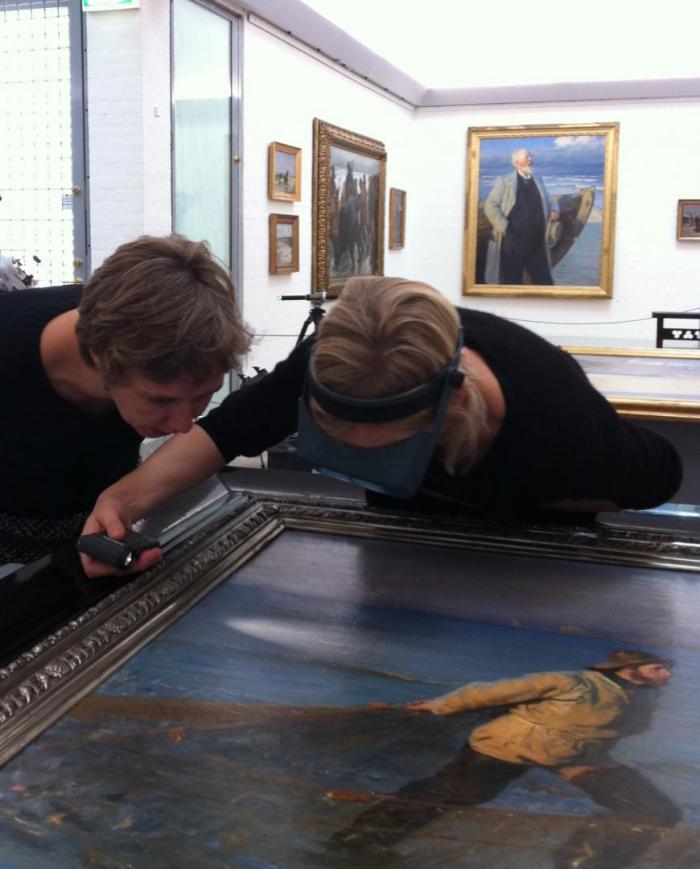
New art historical research on Krøyer’s late paintings was published in 2001 when Skagens Museum celebrated the 150th anniversary of Krøyer’s birth with an exhibition focusing on his late works. The central idea of the exhibition was to place the paintings in a broader artistic – and international – context. The display came in the wake of a general art historical and public interest in Krøyer, which a number of publications and various forms of dissemination illustrate.1 The exhibition was followed by the 2011-2012 exhibition Krøyer – an international perspective shown at The Hirschsprung Collection and Skagens Museum. This exhibition and an accompanying comprehensive publication presented the outcome of further art historical research into the artist and his European connections and sources of inspiration.
During preparation for Krøyer – an international perspective conservators from Kunstkonserveringen (The Art Conservation Center, known then as Fælleskonserveringen, in Aarhus) surveyed approximately 130 works by Krøyer, and found recurring damage phenomena in several of his paintings from the 1880s and 1890s. The 1893 painting Summer Evening on Skagen’s Beach was examined by The National Museum of Denmark in collaboration with Kunstkonserveringen in 2005 to identify why the paint was adhering poorly to the ground.2 The many tiny losses observed could not be easily explained but attention was drawn to sand grains found in the paint, which were approximately the same size as the losses. The fact that the paint layer contained zinc white was not mentioned as a possible factor in the damage found. Considering the increasing focus on the possible side effects of zinc in oil paint,3 this study sets out – using non-invasive in situ techniques – to investigate the presence of zinc white and its possible role in the degradation of Krøyer’s paintings. [fig.1]
This article will focus on P.S. Krøyer’s paintings from the 1880s and 1890s by adding an interdisciplinary technical perspective to the art historical focus of recent years.4 The ambition is that of identifying and understanding the types of damage phenomena that have proved recurrent in the paintings of the period. These observations of damage and its extent will be described and compared to Krøyer’s use of pigments with a particular focus on white pigments.
The preservation state of Krøyer’s paintings
Two types of deterioration are dominant on Krøyer’s paintings from the 1880s and 1890s; problems that are both related to delamination between the ground layer and the thin and brittle paint layers.

The first type of deterioration can be described by the term ‘tenting’. This phenomenon is characterized by a lifting of the paint and ground layers in the form of a triangular tent, when seen in profile, due to compression caused by dimensional changes in the underlying canvas support. [fig.2]
Because of this compression, there is little or no space for the paint layer to return to its original position. It has been shown that these formations are not only the result of the propensity of the canvas to shrink, but are also related to the properties of the preparation layers, that is, the glue and ground layers applied to the canvas before design layers are added.5
The tent formations on Krøyer’s paintings are typically the same width as the threads in the canvas weave and most frequently occur parallel to one of the weave directions. Tenting can cause loss of paint, which usually follows the pattern of the canvas weave. [fig.3a and 3b] In some cases, the paint layer seems to be wrinkling as if it is too big for the support. Tenting as described here is seen in many colour are as, but it seems to be more frequent in light colours such as the large blue areas in the beach and fishermen motifs of the artist’s paintings from the 1880s onwards.
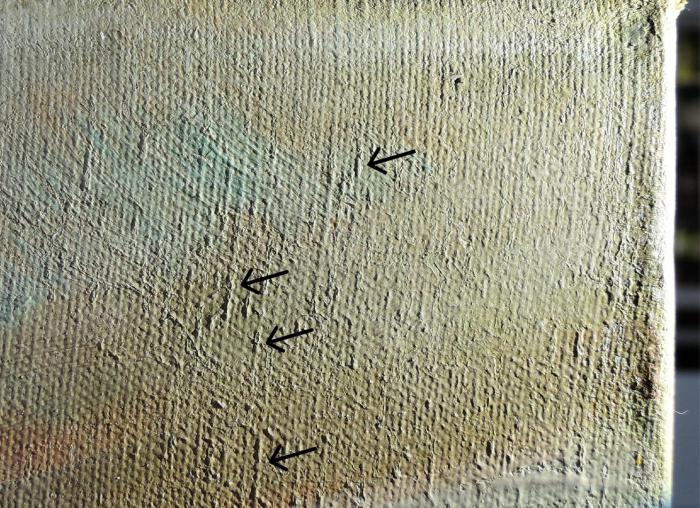
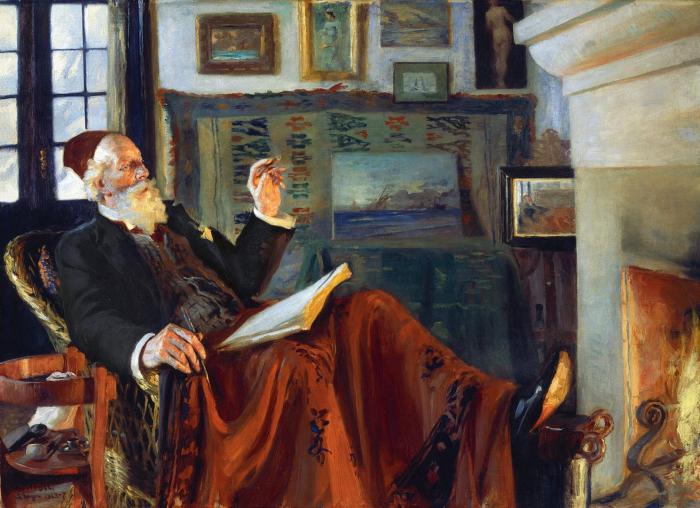
The second type of deterioration observed is minute, but extensive, losses in the paint layer due to poor adhesion between the paint and ground layers. [fig. 4a and 4b] These losses, which are observed in all colours, can occur without visible crack formation or lifting of the paint layer, which are otherwise commonly connected to the occurrence of paint loss. The extent and amount of the losses varies from one painting to another. Both tenting and minute losses have been observed in a number of paintings from the Krøyer – an international perspective exhibition, but seem to be found less often in Krøyer’s early paintings and in his painted sketches on canvas.
The artist’s travels and the hunger for knowledge of materials
A cosmopolitan at heart, Krøyer kept himself apprised on international developments throughout his career. After his first journey to Berlin in 1875 he went abroad every year, with very few exceptions, with the objective of improving his painting skills.6 He found inspiration in Old Master drawings and paintings, both in his younger years at the Academy of Art in Copenhagen and later on travels abroad.7 In particular, he obtained skills in colour rendering and painterly techniques as a pupil at Léon Bonnat’s school in Paris (from the summer and into the winter of 1877).
Due to the increasing industrialization of the production of painting materials in the 1700s and 1800s, direct knowledge of materials and their properties was no longer available to artists in the period in which Krøyer and his contemporaries painted. This knowledge was no longer taught at the art academies, which meant that artists had to obtain it elsewhere.8 Krøyer’s many travels abroad may be seen in this light; this longing for inspiration was perhaps not so much a departure from existing tradition as a simple need to learn about new painting materials and how to use them.9
A new white
Lead white had for centuries been the only white pigment that could be used in oil paint, but in 1780 an initial attempt was made to introduce the zinc oxide (ZnO) as a substitute for the highly toxic lead white. Due to economic reasons, however – zinc white being four times more expensive than lead white – this initial attempt was unsuccessful. There was also a difference in the properties of the two pigments in oil: zinc white had a clear white colour and better suspension properties, while lead white had better hiding power and drying attributes. After several attempts in France between 1835 and 1844, the hiding power of the zinc oxide pigment was improved and siccatives were introduced to improve the drying properties of the pigment in oil. As zinc manufacturing methods improved, the cost of zinc oxide decreased, and zinc white pigment became gradually more popular within the artist community. Even though zinc white was known since the Middle Ages, it was rarely used as a pigment before the 1830s. There are reports of the use of zinc white by several of Krøyer’s contemporaries in France, including Vincent van Gogh, Paul Cezanne, Édouard Manet and Camille Pissarro.10
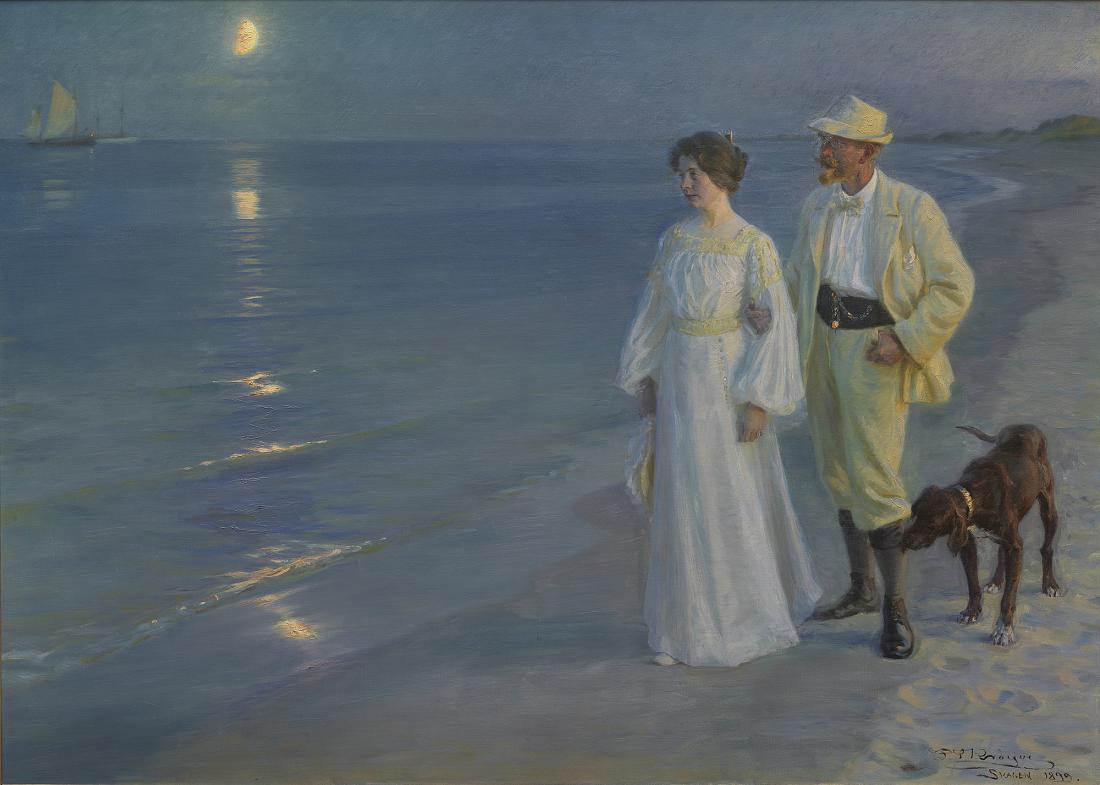
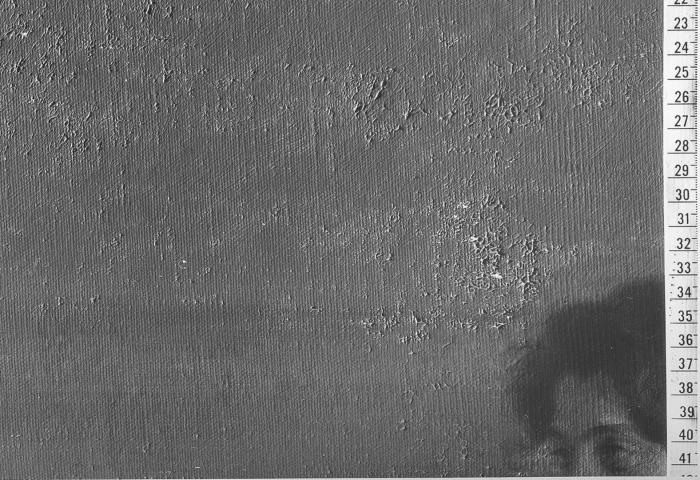
Skagen and the light
The pursuit of light was a recurring theme for Krøyer and his international contemporaries. Krøyer travelled to Skagen for the first time in 1882 and his rendering of the evocative twilight blue seems to reflect the myth of a special Skagen light. In fact, he was one of the first to mention a particular light in Skagen,11 but the suggested theory of an exclusive meteorological phenomenon has been effectively refuted.12
In 1889, the newly-wed Krøyer and Marie (née Triepcke, 1867-1940) travelled from Germany to Denmark and then to Italy for their honeymoon. Prior to their return to Skagen in 1890, Krøyer re-furbished his studio readying it for the work he had planned while abroad. In a letter, he requested that the walls of his studio be painted white as he wanted to work using “an entirely new method”.13 He does not explain this new method further, but it can probably be seen as a continuation of his striving to convey a sense of brightness and sun on the canvas.14 Krøyer’s blue beach paintings from the 1890s mark a shift in his colour scheme. Although he had always worked with the rendering of light through the use of colours, in his later beach paintings he shows a special interest in brighter and lighter colours.15 The sea at Amalfi, one of the places he and Marie visited on their honeymoon, has been named as Krøyer’s first big inspiration for paintings dominated by sea.16
The difficult task of preserving Krøyer’s late canvas paintings
The archives of Kunstkonserveringen contain conservation treatment records from 1978 up to the present. According to the archival material, 74 Krøyer paintings have been treated of which 59 have canvas supports. The paintings date from 1867 to 1909, thus spanning Krøyer’s complete oeuvre. Despite a lack of precision in the descriptions of structural damage on the canvas paintings, it is possible to draw some conclusions regarding recurring damage: there are frequent notes reporting weak adhesion between the paint and ground layers, and in addition, twelve records of the 59 state that there are many small losses either locally or all over the painted surface. The conservation records of Kunstkonserveringen and The National Gallery of Denmark clearly show that water-based consolidants have been avoided for the structural treatment of Krøyer paintings. Conservators are aware of the shrinkage risk associated with these paintings; an awareness that is based on both practical experience as well as knowledge of the negative effect of water treatments on canvas paintings from the 1800s in general.17 Thus, the files generally show that lining with a mixture of wax and resin was preferred for these paintings up until the 1970s when the conservation praxis changed towards consolidation with an acrylic polymer in solvent instead of lining.18
Many of Krøyer’s late paintings tell us a story of repeated structural conservation treatments that appear to have had little positive effect on the stability of the paintings over the long term.19 The 1983 conservation report on the painting Summer evening on the beach at Skagen, 1899, states that the paint is falling off in tiny pieces. This is particularly the case in the upper part of the painting, which is dominated by the blue sky and sea. [fig. 4a og 4b] This painting had to be impregnated six times with the acrylic binder Plexisol before the paint was considered reattached. [see table 1]
Table 1 and 2


Krøyer’s palette
Given the existence of numerous new industrially-produced painting materials in the 1800s, it is interesting to explore if Krøyer employed these new materials and if the use of new materials had consequences for the paintings’ technical conditions. Of the 130 Krøyer paintings surveyed, eight paintings on canvas from the 1880s and 1890s were selected to be investigated further. [see table 1]
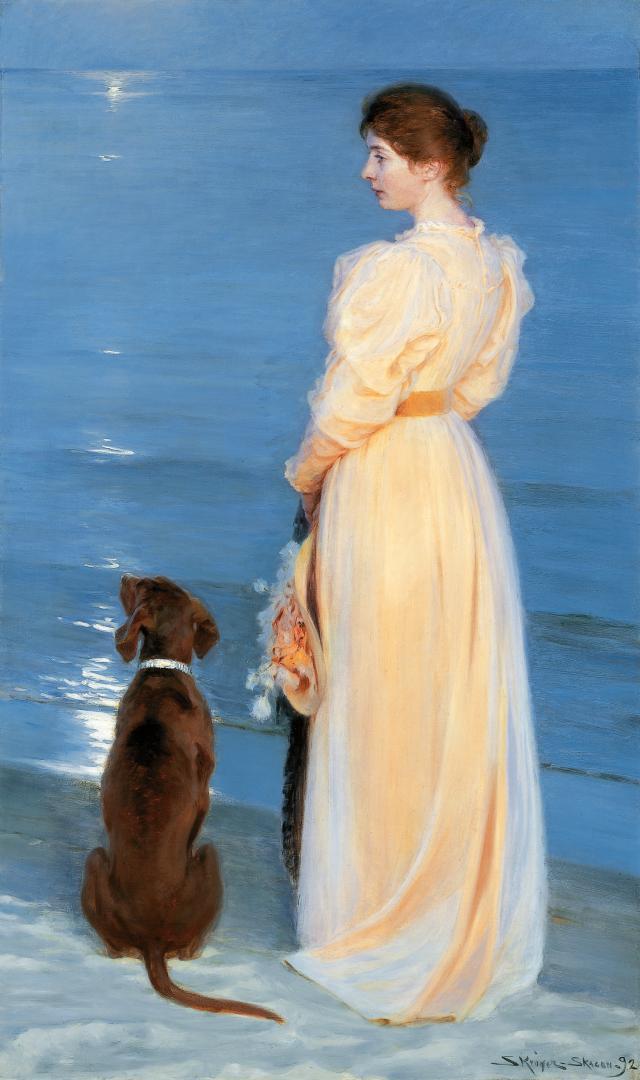
The conservation histories of the eight art works are well documented. Paintings dominated by blue colours were selected in order to simplify the pigment examination, and of the eight paintings five showed or have in the past shown the previously-described damage phenomena in the paint layers (nos. 2, 3, 6, 7 and 8), whereas three were in a good state of preservation (nos. 1, 4 and 5).
The pigments in the eight selected paintings were examined non-destructively using a handheld X-ray fluorescence (XRF) instrument.20 [fig. 5a og 5b] The results are summarized in table 2. Blue areas were tested on all of the paintings, and in cases where other colours were examined as well, those pigments are also listed in the table. The paintings were either in storage or removed from the wall so that the canvas could be examined. The ground layers were analyzed along the tacking margins, and it was found that Krøyer used white primed canvases. The supports are assumed to be cut from rolls of pre-primed canvas, based on the fact that a smooth, continuous ground layer is present around the sides and the back of the stretcher, and no bare canvas is seen. This indicates that the canvases were not prepared directly on the stretchers. A strong lead signal was found in each case suggesting that lead white is a major component in the ground layer. The same type of ground was found by Mads Chr. Christensen and his colleagues in 2005.21
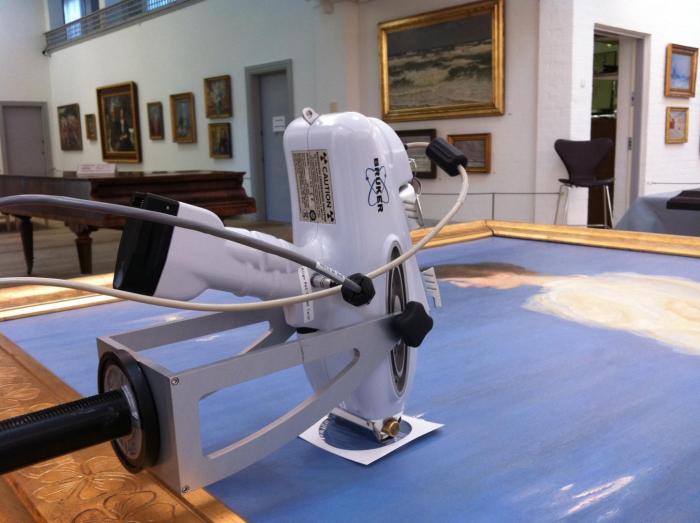
The most significant result of the XRF analysis is that sometime in the late 1880s, Krøyer switched from lead white (2PbCO3.Pb(OH)2) to zinc white (ZnO) in his paint layers. None of the earlier paintings tested contain zinc, whereas all of the later artworks show the presence of zinc. There is no evidence of a mixture of white pigments in the paint layers. The shape of the XRF spectrum indicates that the lead signal in the later paintings comes from a layer behind the surface (i.e. the ground layer). [fig. 6a og 6b] A single test was performed on a painting with a wooden support, which would not have the prepared lead white layer, and the only element detected that could be attributed to a white pigment was zinc. Christensen et al. found only zinc in the paint layers when they examined cross-sections using SEM-EDS.
Krøyer used cobalt blue (CoO.Al2O3) in all of the analyzed paintings, and iron was found in several paintings, suggesting the use of iron earth pigments.22 Chromium was found in greener areas and is likely due to chrome oxide green or viridian (chrome oxide hydrate (Cr2O3.2H2O)). Antimony was identified in one early painting (no. 3) and cadmium in several. These two elements are used in the yellow pigments Naples yellow (Pb(SbO3)2) and cadmium yellow (CdS), respectively. Vermilion (HgS) was found in several of the early paintings, but in none of the later ones. Analyses of red and purple areas in the portrait of Marie Krøyer (no. 5) found none of the inorganic elements usually associated with red pigments, which suggests that Krøyer used organic reds in this painting.
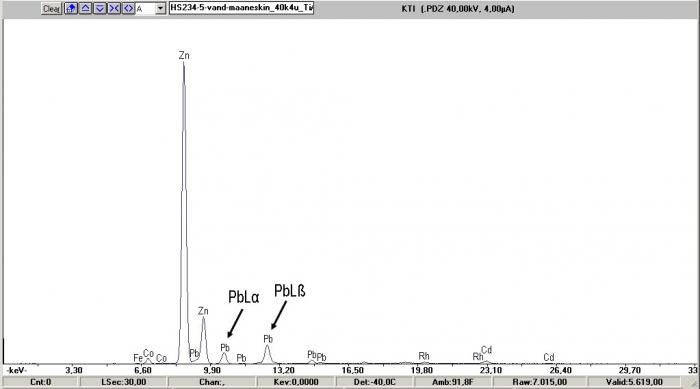
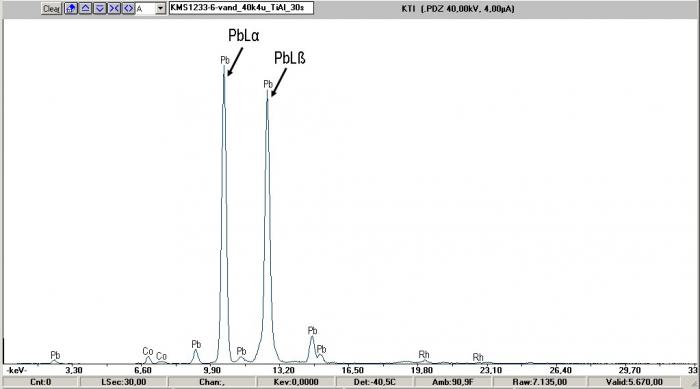
Conclusions and future perspectives
Non-invasive in situ analysis of the eight paintings selected for this preliminary study showed that all of the ground layers contained lead, whereas zinc was present only in the paint layers of the investigated paintings made after 1889. The question remains as to when exactly Krøyer started to use zinc white, and the answer is likely to be somewhere between 1884 and 1889. The introduction of this new pigment to Krøyer’s palette in the late 1880s could be a result of a familiarity with zinc white obtained while he was in France. He may have wished to take advantage of the properties of this white pigment, as it provides a cooler white tone and he may have wanted to use this quality to convey the light at Skagen in his paintings. Compared to the more opaque lead white, due to its translucency zinc white gives a brilliant and cool hue when mixed with other pigments. This property makes zinc white well-suited for depicting brightness when rendering colour without introducing too much ‘whiteness’ to the overall colour scheme. Visually the brightness in the colour tone of Krøyer’s late beach paintings is likely due to the use of zinc white. Krøyer’s wish to redecorate and repaint his studio white after his honeymoon and his mentioning of a new method may be directly reflected in his choice of pigments when he took up his Skagen motifs again.
Krøyer’s later palette could be examined further. This initial study found a change in his use of white pigments, but it has not yet been determined whether he altered his palette overnight or whether there was a gradual change between 1884 and 1889. This study also shows that he switched from older yellow and red pigments to newer ones, including organic reds.
Since damage was found in paintings from both before and after this change to zinc white, there is no basis to conclude that the delamination problems in Krøyer’s paintings can be explained exclusively by the use of zinc white, though it may add to an already existing problem. The painting formats may also be a matter of concern: smaller paintings seem to be less damaged, but the degree of slackness as well as the potential for shrinkage is greater when the formats are larger. Changing canvas production methods may be a possible explanation for the contractions causing tenting in the paint layers, but as mentioned earlier it is also necessary to look towards possible degradation phenomena in the paint film itself.23 The small losses may be caused by metal soap formation in the paint due to a chemical reaction between the zinc or lead in the pigments and free fatty acids from the degraded oil film.24 However, this still remains to be investigated.
In other words, further studies are needed to provide a more complete explanation for the paint layer damage seen in many of Krøyer’s late paintings – and in the paintings of his contemporaries. The detailed chemical and physical degradation processes in the paint film remain to be understood in order to provide a theoretical basis for future conservation of Krøyer’s works and for defining recommendations for the climatic conditions in which the works should be kept in the future. ▢
Acknowledgements
The title of the article refers to A. Johansen and M.B. Jensen: Harmony in blue, P.S. Krøyer’s Poetic Paintings from the 1890s, exhibition catalogue, Skagens Museum, Denmark 2001.
The title illustration is a detail of P.S. Krøyer: Summer evening at Skagen. 1892. Oil on canvas. 206 x 123 cm. Ny Carlsberg Glyptotek, inv. no. MIN 0905, dep. at Skagens Museum, dep. no. 2. Photo: Art Museums of Skagen.
The authors wish to thank Skagens Museum, The National Gallery of Denmark, The Hirschsprung Collection and the Art Conservation Centre for kindly allowing us access to paintings and conservation records. A special thanks to Miriam Watts for art historical assistance and to Mikkel Scharff and Jørgen Wadum for help and inspiration.
